Model Simulation of M2 Internal Tide at the Mariana Double Ridges
Abstract
1. Introduction
2. Methodology
2.1. Model Setup
2.2. Model Validation
2.3. Estimation Method
Dissipation Rate and Diapycnal Mixing
3. Results
3.1. The Barotropic Tidal Energy and Baroclinic Tidal Current
3.2. Baroclinic Energy Flux
3.3. Amplitude and Phase of Internal Tide Current
3.4. Temporal Variation of Baroclinic Current
3.5. Conversion Rate
3.6. Dissipation and Diapycnal Mixing
4. Discussion
4.1. Enhancement of Conversion Dissipation and Divergence
4.2. Energy Budget
5. Summary
Author Contributions
Funding
Institutional Review Board Statement
Informed Consent Statement
Data Availability Statement
Conflicts of Interest
References
- Munk, W.H. Abyssal recipes. Deep. Sea Res. Oceanogr. Abstr. 1966, 13, 707–730. [Google Scholar] [CrossRef]
- Munk, W.; Wunsch, C. Abyssal recipes II: Energetics of tidal and wind mixing. Deep. Sea Res. I Oceanogr. Res. Pap. 1998, 45, 1977–2010. [Google Scholar] [CrossRef]
- Huang, R.X. Mixing and energetics of the oceanic thermohaline circulation. J. Phys. Oceanogr. 1999, 29, 727–746. [Google Scholar] [CrossRef]
- Wunsch, C.; Ferrari, R. Vertical mixing, energy, and the general circulation of the oceans. Annu. Rev. Fluid Mech. 2004, 36, 281–314. [Google Scholar] [CrossRef]
- Gregg, M.C. Diapycnal mixing in the thermocline: A review. J. Geophys. Res. Space Phys. 1987, 92, 5249–5286. [Google Scholar] [CrossRef]
- Toole, J.M.; Schmitt, R.W.; Polzin, K.L.; Kunze, E. Near-boundary mixing above the flanks of a midlatitude seamount. J. Geophys. Res. Space Phys. 1997, 102, 947–959. [Google Scholar] [CrossRef]
- Ledwell, J.R.; Watson, A.; Law, C.S. Mixing of a tracer in the pycnocline. J. Geophys. Res. Space Phys. 1998, 103, 21499–21529. [Google Scholar] [CrossRef]
- Egbert, G.D.; Ray, R.D. Significant dissipation of tidal energy in the deep ocean inferred from satellite altimeter data. Nat. Cell Biol. 2000, 405, 775–778. [Google Scholar] [CrossRef] [PubMed]
- Laurent, L.C.S.; Simmons, H.L.; Jayne, S. Estimating tidally driven mixing in the deep ocean. Geophys. Res. Lett. 2002, 29. [Google Scholar] [CrossRef]
- Ledwell, J.R.; Montgomery, E.; Polzin, K.L.; Laurent, L.C.S.; Schmitt, R.W.; Toole, J.M. Evidence for enhanced mixing over rough topography in the abyssal ocean. Nat. Cell Biol. 2000, 403, 179–182. [Google Scholar] [CrossRef] [PubMed]
- Wang, X.; Peng, S.; Liu, Z.; Huang, R.X.; Qian, Y.-K.; Li, Y. Tidal mixing in the South China Sea: An estimate based on the internal tide energetics. J. Phys. Oceanogr. 2016, 46, 107–124. [Google Scholar] [CrossRef]
- Cox, C.; Sandstrom, H. Coupling of internal and surface waves in water of variable depth. Deep. Sea Res. Oceanogr. Abstr. 1964, 11, 659–660. [Google Scholar] [CrossRef]
- Bell, T.H. Lee waves in stratified flows with simple harmonic time dependence. J. Fluid Mech. 1975, 67, 705–722. [Google Scholar] [CrossRef]
- Bell, T.H. Topographically generated internal waves in the open ocean. J. Geophys. Res. Space Phys. 1975, 80, 320–327. [Google Scholar] [CrossRef]
- Hibiya, T. Generation mechanism of internal waves by tidal flow over a sill. J. Geophys. Res. Space Phys. 1986, 91, 7697. [Google Scholar] [CrossRef]
- Llewellyn Smith, S.G.; Young, W.R. Conversion of the barotropic tide. J. Phys. Oceanogr. 2002, 32, 1554–1566. [Google Scholar] [CrossRef]
- Balmforth, N.J.; Ierley, G.R.; Young, W.R. Tidal conversion by subcritical topography. J. Phys. Oceanogr. 2002, 32, 2900–2914. [Google Scholar] [CrossRef]
- Radko, T.; Marshall, J. Eddy-induced diapycnal fluxes and their role in the maintenance of the thermocline. J. Phys. Oceanogr. 2004, 34, 372–383. [Google Scholar] [CrossRef]
- Holloway, P.E.; Merrifield, M.A. Internal tide generation by seamounts, ridges, and islands. J. Geophys. Res. Space Phys. 1999, 104, 25937–25951. [Google Scholar] [CrossRef]
- Merrifield, M.A.; Holloway, P.E.; Johnston, T.M.S. The generation of internal tides at the Hawaiian Ridge. Geophys. Res. Lett. 2001, 28, 559–562. [Google Scholar] [CrossRef]
- Zilberman, N.V.; Becker, J.M.; Merrifield, M.A.; Carter, G.S. Model estimates of M2 internal tide generation over Mid-Atlantic ridge topography. J. Phys. Oceanogr. 2009, 39, 2635–2651. [Google Scholar] [CrossRef]
- Buijsman, M.C.; Klymak, J.M.; Legg, S.; Alford, M.H.; Farmer, D.; MacKinnon, J.A.; Nash, J.D.; Park, J.-H.; Pickering, A.; Simmons, H. Three-dimensional double-ridge internal tide resonance in Luzon Strait. J. Phys. Oceanogr. 2014, 44, 850–869. [Google Scholar] [CrossRef]
- Niwa, Y. Three-dimensional numerical simulation of M2internal tides in the East China Sea. J. Geophys. Res. Space Phys. 2004, 109. [Google Scholar] [CrossRef]
- Wang, Y.; Xu, Z.; Yin, B.; Hou, Y.; Chang, H. Long-range radiation and interference pattern of multisource M 2 internal tides in the Philippine Sea. J. Geophys. Res. Oceans 2018, 123, 5091–5112. [Google Scholar] [CrossRef]
- Legg, S.; Adcroft, A. Internal wave breaking at concave and convex continental slopes. J. Phys. Oceanogr. 2003, 33, 2224–2246. [Google Scholar] [CrossRef]
- Nikurashin, M.; Legg, S. A Mechanism for local dissipation of internal tides generated at rough topography. J. Phys. Oceanogr. 2011, 41, 378–395. [Google Scholar] [CrossRef]
- Han, B.; Eden, C. The energetics of internal tides at the Luzon Ridge. Ocean. Dyn. 2019, 69, 1009–1022. [Google Scholar] [CrossRef]
- Mazloff, M.R.; Cornuelle, B.; Gille, S.T.; Wang, J. The importance of remote forcing for regional modeling of internal waves. J. Geophys. Res. Oceans 2020, 125. [Google Scholar] [CrossRef]
- Zhao, Z.; D’Asaro, E. A perfect focus of the internal tide from the Mariana Arc. Geophys. Res. Lett. 2011, 38. [Google Scholar] [CrossRef]
- Kerry, C.G.; Powell, B.S.; Carter, G.S. Effects of remote generation sites on model estimates of M2 internal tides in the Philippine Sea. J. Phys. Oceanogr. 2013, 43, 187–204. [Google Scholar] [CrossRef]
- Marshall, J.; Adcroft, A.; Hill, C.; Perelman, L.; Heisey, C. A finite-volume, incompressible Navier Stokes model for studies of the ocean on parallel computers. J. Geophys. Res. Space Phys. 1997, 102, 5753–5766. [Google Scholar] [CrossRef]
- Buijsman, M.C.; Legg, S.; Klymak, J. Double-ridge internal tide interference and its effect on dissipation in Luzon Strait. J. Phys. Oceanogr. 2012, 42, 1337–1356. [Google Scholar] [CrossRef]
- Niwa, Y.; Hibiya, T. Numerical study of the spatial distribution of the M2 internal tide in the Pacific Ocean. J. Geophys. Res. Space Phys. 2001, 106, 22441–22449. [Google Scholar] [CrossRef]
- Tian, J.; Lei, Z.; Zhang, X.; Liang, X.; Wei, Z. Estimates of M2 internal tide energy fluxes along the margin of Northwestern Pacific using TOPEX/POSEIDON altimeter data. Geophys. Res. Lett. 2003, 30, OCE 4-1. [Google Scholar] [CrossRef]
- Klymak, J.M.; Legg, S.M. A simple mixing scheme for models that resolve breaking internal waves. Ocean Model. 2010, 33, 224–234. [Google Scholar] [CrossRef]
- Cummins, P.F.; Oey, L.-Y. Simulation of Barotropic and Baroclinic Tides off Northern British Columbia. J. Phys. Oceanogr. 1997, 27, 762–781. [Google Scholar] [CrossRef]
- Mellor, G.L. Users Guide for a Three-Dimensional, Primitive equation, Numerical Ocean Model; Program in Atmospheric and Oceanic Sciences, Princeton University: Princeton, NJ, USA, 2004. [Google Scholar]
- Nash, J.D.; Alford, M.H.; Kunze, E. Estimating internal wave energy fluxes in the ocean. J. Atmos. Ocean. Technol. 2005, 22, 1551–1570. [Google Scholar] [CrossRef]
- Osborn, T.R. Estimates of the local rate of vertical diffusion from dissipation measurements. J. Phys. Oceanogr. 1980, 10, 83–89. [Google Scholar] [CrossRef]
- Duda, T.F.; Rainville, L. Diurnal and semidiurnal internal tide energy flux at a continental slope in the South China Sea. J. Geophys. Res. Space Phys. 2008, 113. [Google Scholar] [CrossRef]
- Klymak, J.M.; Moum, J.N.; Nash, J.D.; Kunze, E.; Girton, J.B.; Carter, G.S.; Lee, C.M.; Sanford, T.B.; Gregg, M.C. An estimate of tidal energy lost to turbulence at the Hawaiian ridge. J. Phys. Oceanogr. 2006, 36, 1148–1164. [Google Scholar] [CrossRef]
- Lee, C.M.; Sanford, T.B.; Kunze, E.; Nash, J.D.; Merrifield, M.A.; Holloway, P.E. Internal tides and turbulence along the 3000-m isobath of the Hawaiian Ridge. J. Phys. Oceanogr. 2006, 36, 1165–1183. [Google Scholar] [CrossRef]
- Laurent, L.C.S.; Thurnherr, A. Intense mixing of lower thermocline water on the crest of the Mid-Atlantic Ridge. Nat. Cell Biol. 2007, 448, 680–683. [Google Scholar] [CrossRef] [PubMed]
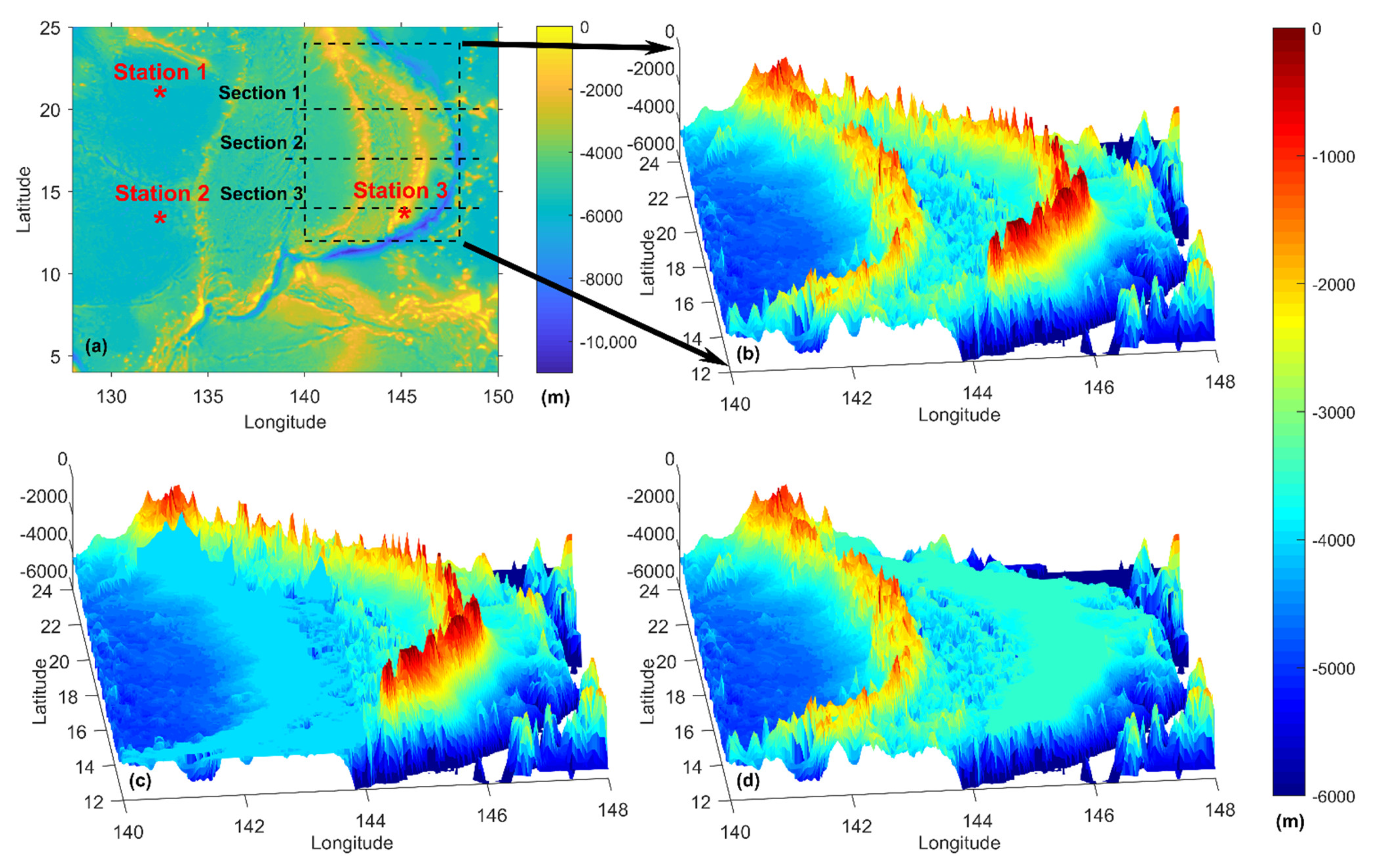




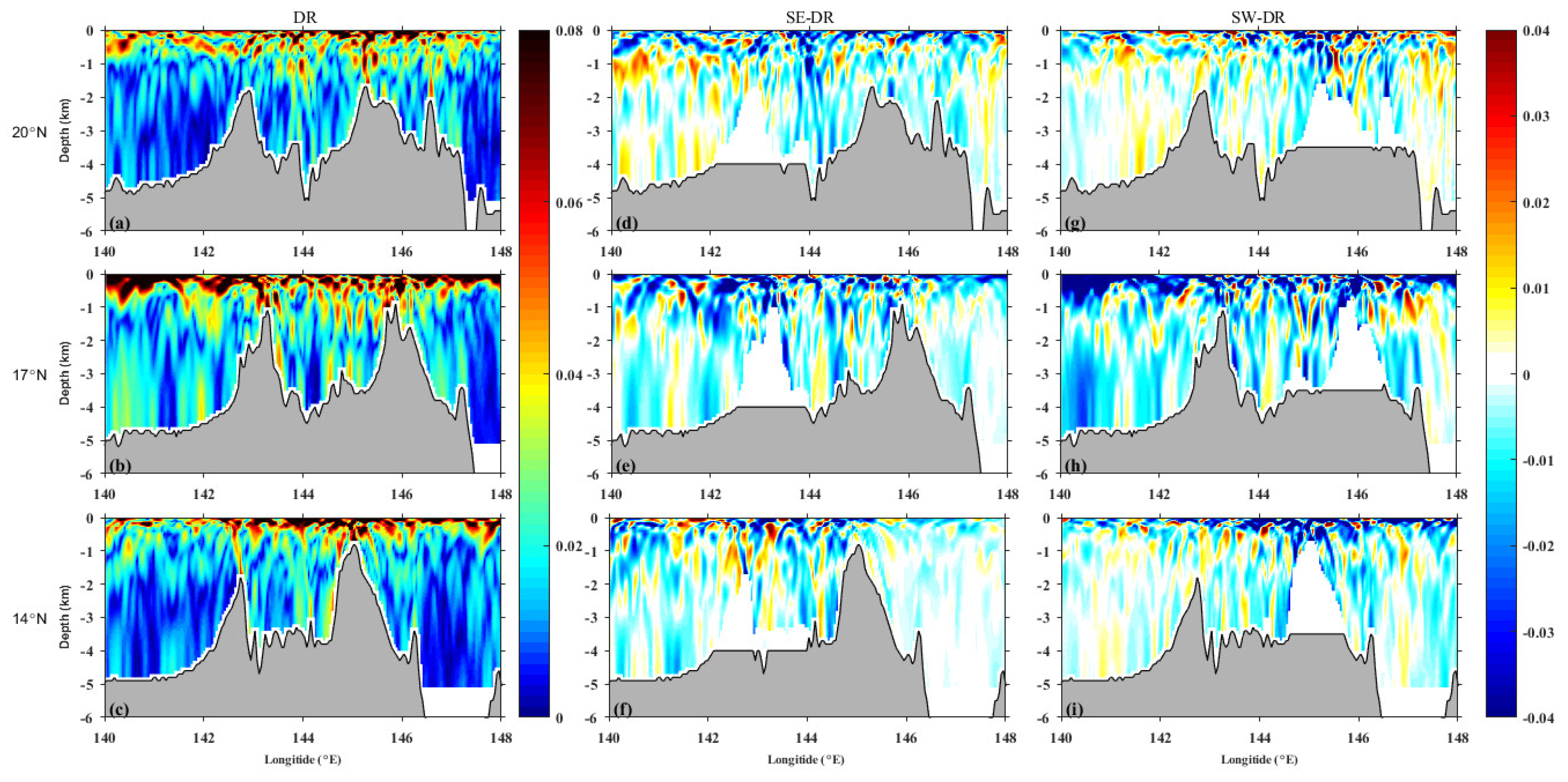
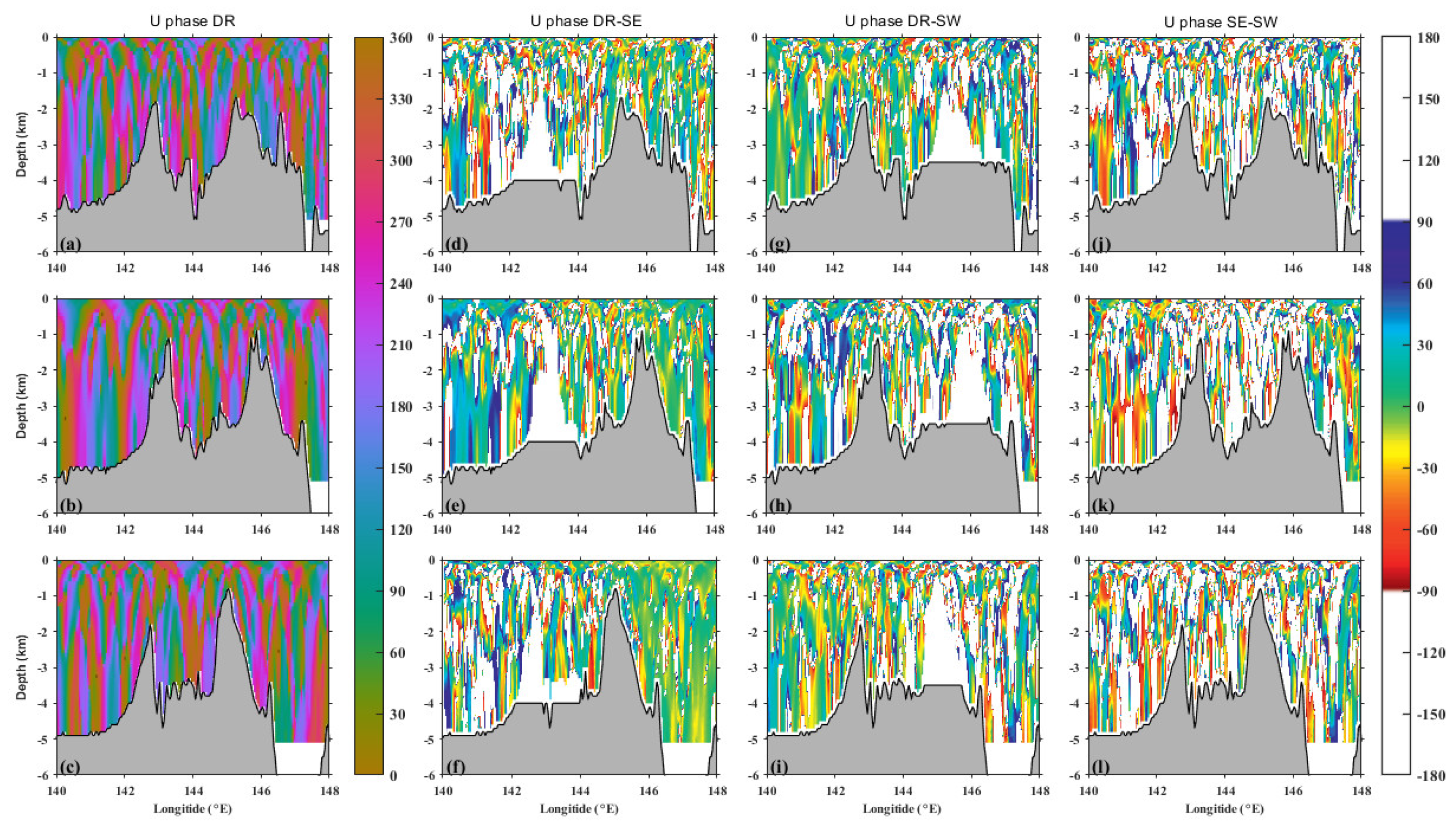
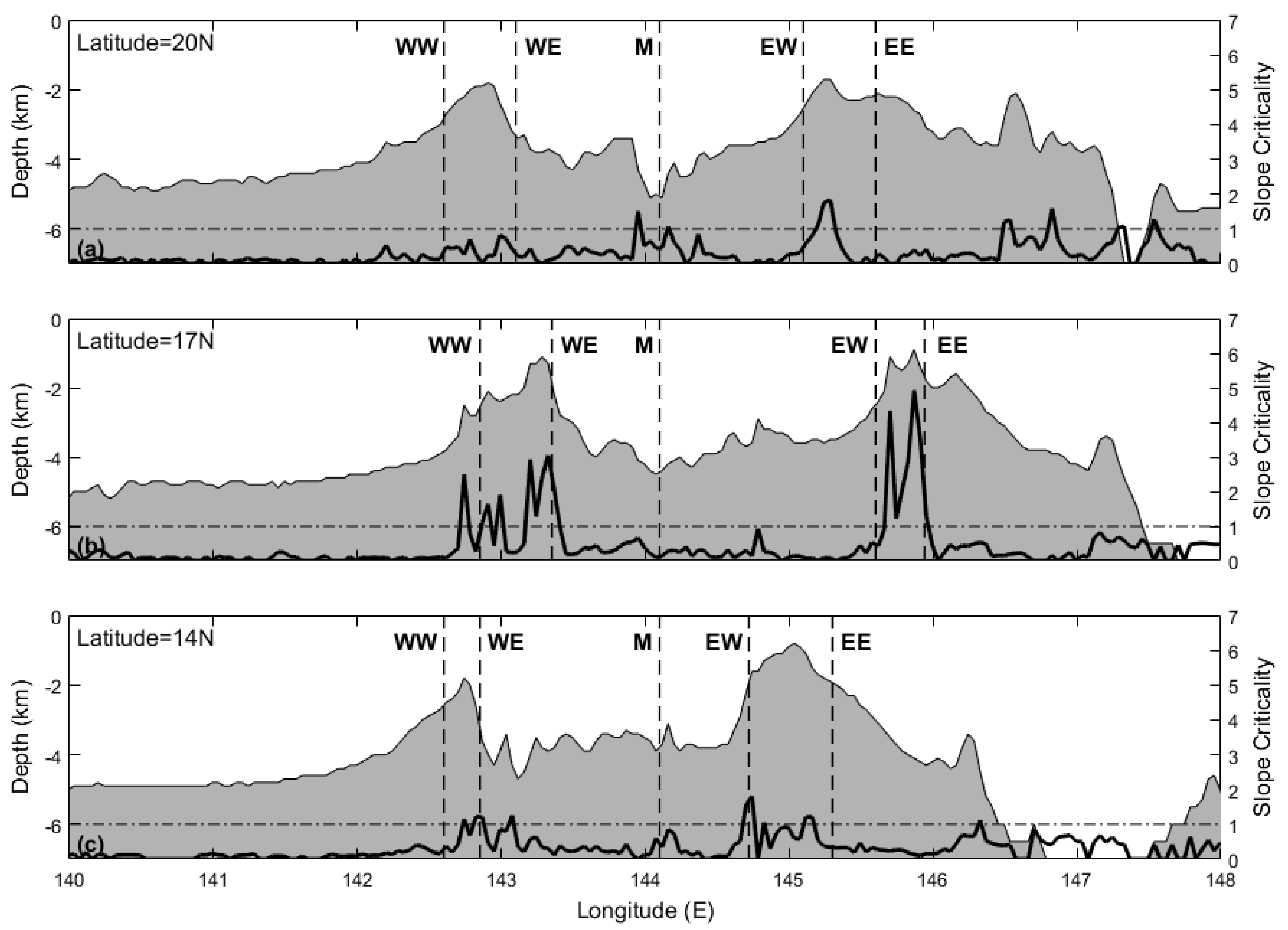

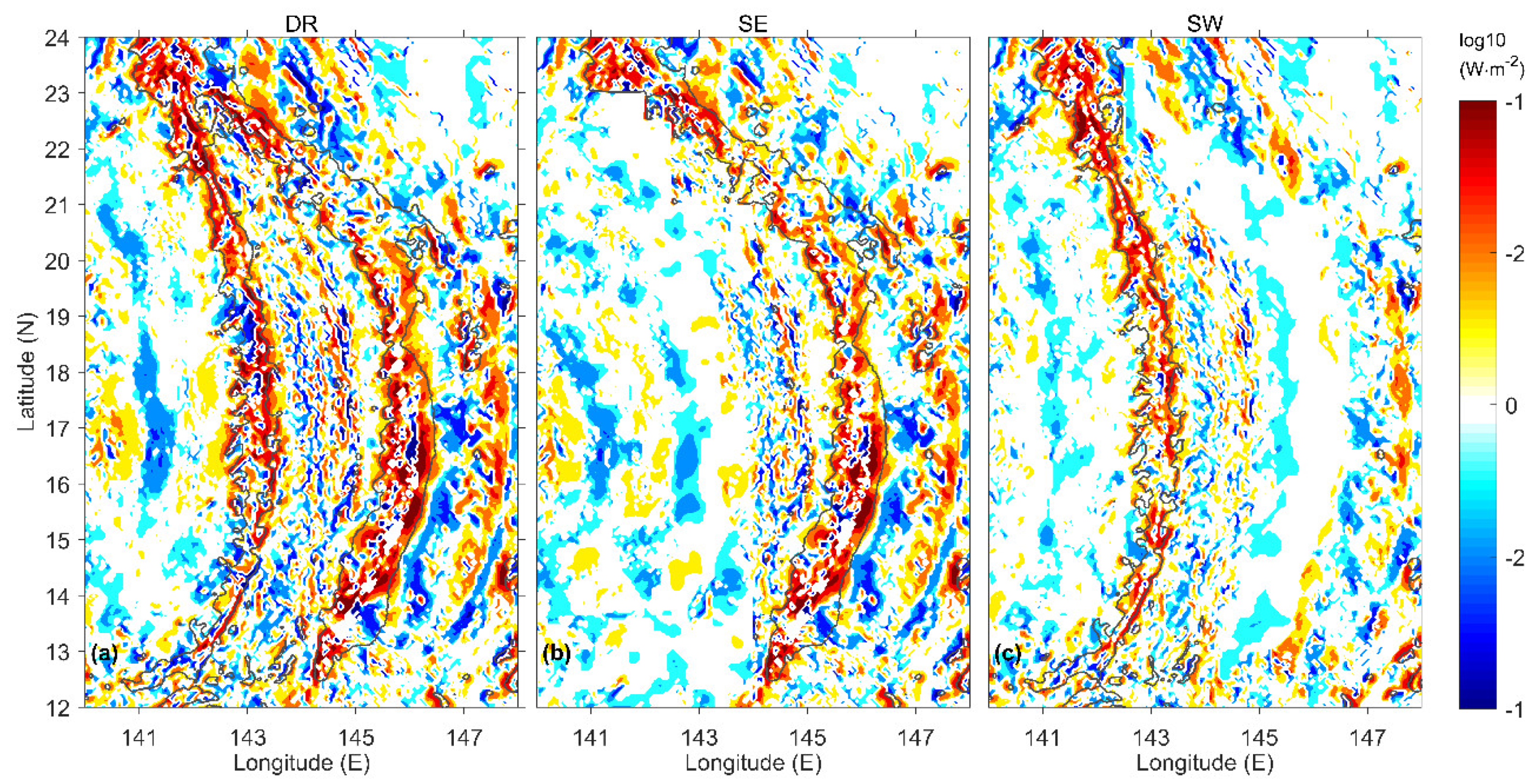

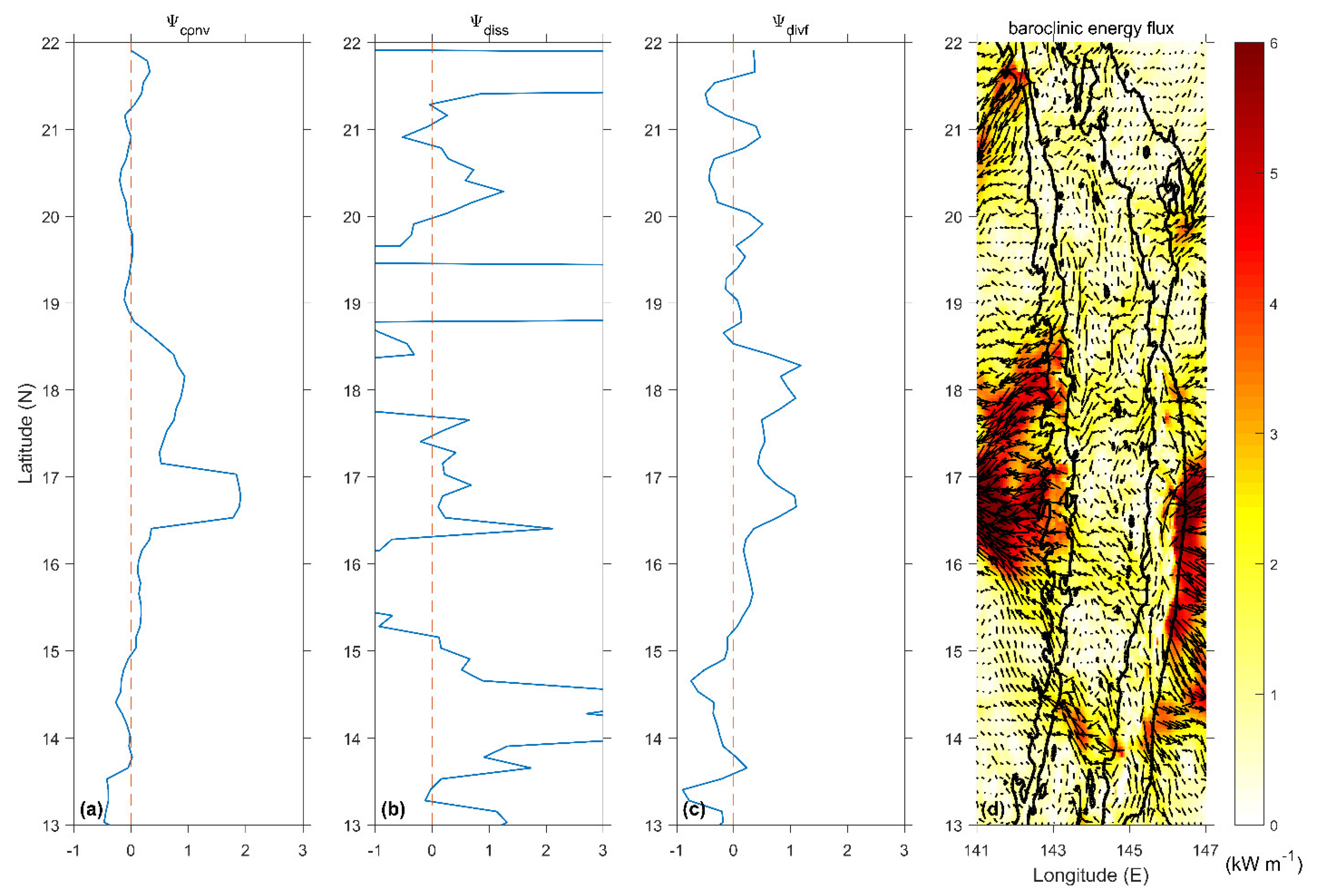

| Station | Amplitude (m) | Phase | RMS (m) | Percentage (%) | |
|---|---|---|---|---|---|
| Station 1 | MITgcm | 0.48 | 281.99 | 0.023 | 4.7 |
| OBS | 0.49 | 285.71 | |||
| Station 2 | MITgcm | 0.52 | 282.62 | 0.059 | 10.7 |
| OBS | 0.55 | 290.98 | |||
| Station 3 | MITgcm | 0.16 | 265.64 | 0.037 | 33.6 |
| OBS | 0.11 | 271.50 |
Publisher’s Note: MDPI stays neutral with regard to jurisdictional claims in published maps and institutional affiliations. |
© 2021 by the authors. Licensee MDPI, Basel, Switzerland. This article is an open access article distributed under the terms and conditions of the Creative Commons Attribution (CC BY) license (https://creativecommons.org/licenses/by/4.0/).
Share and Cite
Chen, Q.; Yu, L.; Yang, Q.; Vetter, P.A.; Xu, H.; Xie, Q.; Jiang, H.; Ni, Z. Model Simulation of M2 Internal Tide at the Mariana Double Ridges. J. Mar. Sci. Eng. 2021, 9, 592. https://doi.org/10.3390/jmse9060592
Chen Q, Yu L, Yang Q, Vetter PA, Xu H, Xie Q, Jiang H, Ni Z. Model Simulation of M2 Internal Tide at the Mariana Double Ridges. Journal of Marine Science and Engineering. 2021; 9(6):592. https://doi.org/10.3390/jmse9060592
Chicago/Turabian StyleChen, Qi’an, Liu Yu, Qingxuan Yang, Philip Adam Vetter, Hongzhou Xu, Qiang Xie, Huichang Jiang, and Zekai Ni. 2021. "Model Simulation of M2 Internal Tide at the Mariana Double Ridges" Journal of Marine Science and Engineering 9, no. 6: 592. https://doi.org/10.3390/jmse9060592
APA StyleChen, Q., Yu, L., Yang, Q., Vetter, P. A., Xu, H., Xie, Q., Jiang, H., & Ni, Z. (2021). Model Simulation of M2 Internal Tide at the Mariana Double Ridges. Journal of Marine Science and Engineering, 9(6), 592. https://doi.org/10.3390/jmse9060592






